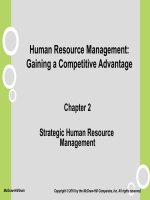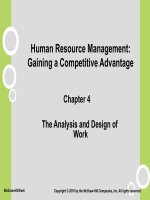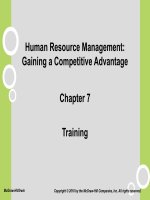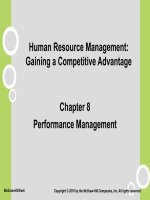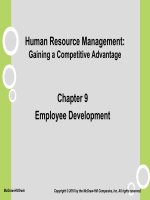HRM gaining a competitive advantage noe ch002
Bạn đang xem bản rút gọn của tài liệu. Xem và tải ngay bản đầy đủ của tài liệu tại đây (203.14 KB, 26 trang )
Human Resource Management:
Gaining a Competitive Advantage
Chapter 2
Strategic Human Resource
Management
McGraw-Hill/Irwin
Copyright © 2010 by the McGraw-Hill Companies, Inc. All rights reserved.
Learning Objectives
1.
Describe the differences between strategy formulation and
strategy implementation.
2.
List strategic management process components.
3.
Discuss HRM function’s role in strategy formulation.
4.
Describe the linkages between HRM and strategy formulation.
5.
Discuss typologies of strategies and associated
HRM practices.
6.
Describe HR issues and practices associated with various
directional strategies.
2-2
Introduction
Goal of strategic management is to
deploy and allocate resources in a way
that gives an organization competitive
advantage.
HRM function must be integrally
involved in the company’s strategic
management process.
2-3
What is Strategic Management?
Strategic human resource management
is the pattern of planned HR activities
and deployments intended to enable an
organization to achieve its goals.
Strategic management is a process to
address the organization’s competitive
challenges.
2-4
Strategic Management Process Phases
Strategy
StrategyFormulationFormulationprocess
processof
ofdeciding
deciding
company’s
company’sstrategic
strategic
direction
directionby
bydefining
definingits
its
mission
missionand
andgoals,
goals,
external
externalopportunities
opportunities
and
andthreats,
threats,and
andinternal
internal
strengths
strengthsand
andweaknesses.
weaknesses.
Strategy Implementationprocess of devising
structures and allocating
resources to enact a
company’s chosen
strategy.
2-5
5 Categories of Directional Strategies
Concentration
Concentration
Internal
Internal Growth
Growth
External
External Growth
Growth
Downsizings
Downsizings
Mergers
Mergers && Acquisitions
Acquisitions
2-6
5 Strategic Management Process
Components
Mission
Mission
Goals
Goals
External
External Analysis
Analysis
Internal
Internal Analysis
Analysis
Strategic
Strategic Choice
Choice
2-7
HRM Practices
• Job Analysis - the process of
getting detailed information
about jobs.
• Recruitment - the process
through which the
organization seeks applicants.
• Training - a planned effort to
facilitate learning of jobrelated knowledge, skills, and
behavior.
•
• Job design - making decisions
about what tasks should be
grouped into a particular job.
• Selection - identifying the
applicants with the appropriate
knowledge, skills, and ability.
• Development - the acquisition
of knowledge, skills, and
behavior that improves
employees' ability to meet the
challenges of future jobs.
Performance management - helps ensure that employees’
activities and outcomes are congruent with the
organization’s objectives.
• Pay structure, incentives, and benefits.
• Labor and employee relations.
2-8
Strategic Management Process Model
Strategy Formulation
Strategy Implementation
HR Practices
External Analysis
•Opportunities
•Threats
Mission
Goals
Strategic
Choice
Internal
Analysis
•Strengths
•Weaknesses
Human
Resource
Needs
•Skills
•Behavior
•Culture
•Recruiting
•Training
•Performance management
•Labor relations
•Employee relations
•Job analysis
•Job design
•Selection
•Development
•Pay structure
•Incentives
•Benefits
Human
Resource
Capability
•Skills,
•Abilities
•Knowledge
Firm
Performance
•Productivity
•Quality
•Profitability
Human
Resource
Actions
•Behaviors
•Results
2-9
StrategyDecisions About Competition
Where, how and with what will we
compete?
Where- in what markets?
How – what criteria?
–
–
–
–
cost?
quality?
reliability?
delivery?
With what resources?
- How will we acquire, develop and deploy
resources?
2-10
Strategic Planning and HRM
Linkages
2-11
Strategy Formulation
External
Analysis
•Opportunities
•Threats
Mission
Strategic
Choice
Goals
Internal
Analysis
•Strengths
•Weaknesses
2-12
Strategy Formulation
Mission is a statement of the organization's reasons for
being.
Goals are what the organization hopes to achieve in the
medium-to long-term future.
External analysis examines the organization's operating
environment to identify strategic opportunities and threats.
Internal analysis identifies the organization's strengths and
weaknesses.
Strategic choice is the organization's strategy, which
describes the ways the organization will attempt to fulfill its
mission and achieve its long term goals.
2-13
Strategy Implementation Variables
Organizational
Organizational
Structure
Structure
Types
Types
of
of
Information
Information
Product
Product
Market
Market
Strategy
Strategy
Task
Task
Design
Design
Performance
Performance
Reward
Reward
Systems
Systems
Select
Select
Train
Train
Develop
Develop
People
People
2-14
Strategic Implementation
HR Practices
Strategic
Choice
Human
Resource
Needs
•Skills
•Behavior
•Culture
•Recruiting
•Training
•Performance management
•Labor relations
•Employee relations
•Job analysis
•Job design
•Selection
•Development
•Pay structure
•Incentives
•Benefits
Human
Resource
Capability
•Skills,
•Abilities
•Knowledge
Firm
Performance
•Productivity
•Quality
•Profitability
Human
Resource
Actions
•Behaviors
•Results
-productivity
-absenteeism
- turnover
2-15
HRM Practices
Job
Job Analysis
Analysis && Design
Design
Recruitment
Recruitment && Selection
Selection
Training
Training && Development
Development
Performance
Performance Mgmt.
Mgmt.
2-16
Job Analysis and Design
Job
Job AnalysisAnalysis-
process
processof
ofgetting
getting
detailed
detailedinformation
information
about
aboutjobs
jobs..
Job Designdefining the way work
will be performed and
tasks required in a
given job.
2-17
Recruitment and Selection
SelectionRecruitmentRecruitment-
process
processof
ofseeking
seeking
applicants
applicantsfor
forpotential
potential
employment.
employment.
process by which an
organization identifies
applicants with
necessary knowledge
skills, abilities and
characteristics that
will help it to achieve
its goals.
2-18
Training and Development
TrainingTraining-planned
planned
effort
effortto
tofacilitate
facilitate
learning
learningof
ofjob-related
job-related
knowledge,
knowledge,skills
skillsand
and
behaviors
behaviors
Development- acquisition
of knowledge, skills and
behaviors that improve
an employee’s ability
to meet changes in job
requirements and in
client and customer
demands.
2-19
Performance Management
…the
means through which managers
ensure that employees’ activities and
outputs are congruent with the
organization’s goals.
2-20
HRM Practice Options
Job Analysis & Design
Recruitment & Selection
Training & Development
Performance Management
Pay Structure, Incentives & Benefits
Labor & Employee Relations
2-21
Strategic Types
Porter's Strategies
…competitive advantage stems from a
company’s ability to create value in
two ways…
Cost leadership
Differentiation
2-22
HRM Needs
Strategic Types
Different strategies require different types of
employees.
Role Behaviors:
Cost strategy firms seek efficiency, carefully
define needed employee skills and use worker
participation to seek cost-saving ideas.
Differentiation firms need creative risk takers.
2-23
Directional Strategies
External Growth
Strategy
Concentration
Strategy
Internal
Growth
Strategy
Downsizing
Mergers and
Acquisitions
2-24
2 Ways HR Provides
Competitive Advantage
1. Emergent Strategies- strategies
that evolve from the grass
roots of the organization.
2. Enhancing Competivenessdeveloping human capital in a
learning organization
2-25

